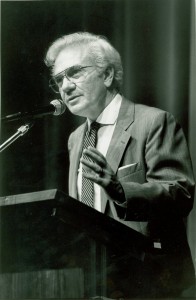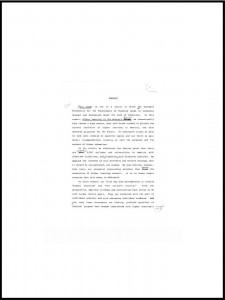
Ernie Boyer delivers a speech in 1987 while serving as president of the Carnegie Foundation for the Advancement of Teaching.
As the Carter administration came to an end in the late 1970s, Boyer took on yet another new role — one that he would hold until the end of his life. As president of the Carnegie Foundation for the Advancement of Teaching (CFAT), Boyer would hold “one of the most prestigious jobs in education,” according to a Washington Post report about his appointment. But the CFAT appointment was also “Ernie’s dream job,” according to his wife, Kay. It was thus both a personal and professional thrill when Boyer assumed the presidency in 1980.
In his role, Boyer was charged with helping to strengthen and improve education at all levels — from kindergarten through university — and to focus not only on students but also on teachers. The books that he wrote during his presidency attest to this broad mandate. Ready to Learn (1991) focused on elementary-level learners, while High School: A Report on Secondary Education in America (1983) focused on older students. College: The Undergraduate Experience in America (1987) and Campus Life: In Search of Community (1990) both centered on higher education. He also wrote for faculty; Scholarship Reconsidered (1990) offered a capacious definition of intellectual productivity and how universities and colleges should reward scholars for their work.
Through his long tenure with the Carnegie Foundation, Boyer remained committed to an educational vision for the common good — a fact evident in his 1981 co-authored report, Higher Learning in the Nation’s Service.
In this book, Boyer and his co-author, Fred Hechinger, paint an overarching mission for colleges and universities, urging them to use the current moment to rediscover how their own unique historic purposes can serve the nation’s interests in new and vital ways.
Read an early manuscript draft of
Boyer and Hechinger’s book
Higher Learning in the Nation’s Service
First, Boyer and Hechinger call on colleges and universities to better serve an increasingly diverse student population: the growing numbers of African American and Hispanic students, as well as older students receiving benefits through programs such as the G.I. Bill.
Second, Boyer and Hechinger urge a vigorous program of independent, university-based research with appropriate linkages to other laboratories and research institutes. The authors acknowledge the benefits of the recent increase in corporate funding for scholarly research: the sharing of costly equipment and supplies, the draw of scholars into business and industry rather than just the academy, the increased support for academic work, and the stimulation of new questions. However, they also warn against the dangers of for-profit research and argue that it should not dominate university research; rather, they plead for a renewal of government funding to make university research independent of special interests. They especially stress the importance of research in sustaining a generation of scholars and maintaining valuable teaching talents — not to mention serving the common good of the nation and its population. Research, they conclude, “cannot be allowed to languish or starve. Sustaining that creative process is absolutely crucial if higher learning is t be truly ‘in the nation’s service'” (46).
Third, Boyer and Hechinger propose a new program of civic education for all students in order to promote public service for the common good. In the wake of some of the nation’s most demoralizing events — the failed war in Vietnam, the corruption exposed by the Watergate scandal, and the concerns about the Iranian hostage crisis — the authors contend that the public is rightly wary of its government and governmental institutions. But they also believe that students, as citizens, have an obligation to serve their nation — either directly in roles of public service, or indirectly as informed voters and engaged participants in the democratic process. They write, “Schools and colleges simply must do a better job of clarifying for students urgent public issues and preparing them to make informed, discriminating judgments on questions that will affect the nation’s future” (54).
Fourth and finally, Boyer and Hechinger advocate that colleges and universities do more to help their students to use knowledge wisely. They contend that higher education has and always should have a dual role: as both servant and critic of society. Higher education, they make clear, should “respond . . . to the national agenda.” But it should also act “as conscience and critic . . . of society, thus risking the displeasure of the established order” (21). This dual role, they state, must be vigorously protected and advanced. “[B]oth strands are equally essential,” the authors conclude. “Taken together they form a remarkable cord of service to the nation” and to its common good (21).

